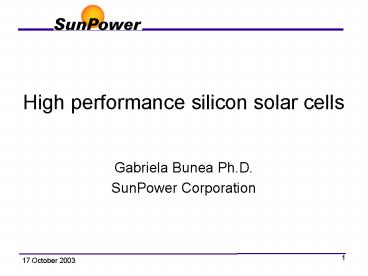High performance silicon solar cells - PowerPoint PPT Presentation
Title:
High performance silicon solar cells
Description:
... $0.75/W Silicon Module Cost Components Factors Driving Past Cost Reduction Poly ... SunPower one-sun Si solar cell Efficiency Losses in Silicon ... – PowerPoint PPT presentation
Number of Views:255
Avg rating:3.0/5.0
Title: High performance silicon solar cells
1
High performance silicon solar cells
- Gabriela Bunea Ph.D.
- SunPower Corporation
2
Outline
- Background
- SunPower brief history
- High efficiency solar cells
- High volume manufacturing
- Future directions
3
Questions often heard from the general public
- Why have solar cells never become a substantial
source of energy? - Too bad solar never made it, it seemed so
promising back in the 1970s. - When will the big breakthrough come that will
make solar cells practical?
4
Answers and fun facts
- Solar cell manufacturing is a vital and rapidly
growing industry, enjoying over 30 annual growth
over the last 10 years. - In 2002, more square inches of silicon was used
by the solar cell industry than the IC industry. - There will be no big breakthrough that impacts
the industry for at least 10 years, and probably
20 years. - Instead, the existing technologies will evolve to
where they will be cost effective in most
distributed applications in 10 years, and will be
competitive with fossil fuel generation in 20
years.
5
Solar Cell Price Exhibits a Classic Experience
Curve Behavior
2002 3/W
6
Solar Cell Rules of Thumb
- The annual production of solar modules increases
ten-fold every decade - The price of solar cell modules decreases by half
every decade - 2002 3.00/W
- 2012 1.50/W
- 2022 0.75/W
7
Silicon Module Cost Components
Higher efficiency leverages cost savings
throughout the value chain Investing in high
efficiency cell processing makes economic sense
8
Factors Driving PastCost Reduction
- Poly silicon price 300/kg ? 30/kg
- Wire saws now lt 0.25/W
- Larger wafers 3 ? 6
- Thinner wafers 15 mil ? 8 mil
- Improved efficiency 10 ? 16
- Volume manufacturing 1MW ? 100MW
- Increased automation none ? some
- Improved manufacturing processes
9
The Renewable Energy Revolution
- Renewable energy will capture a meaningful share
of the Global Energy Market in the next 25
years. - Key drivers will be
- Falling costs for renewable energy
- Declining fossil fuel production
- Increasing energy demand worldwide
- Environmental concerns
Oil industry consensus production will peak
between 2004 and 2010
Source C.J.Campbell World Oil Resources Dec
2000
10
The Future of Renewables Projected World Energy
Production
Source Royal Dutch Shell Group
11
SunPower company history
- 1985 Record efficiency Silicon Solar Cell
developed at Stanford Univ. - 1988 SunPower formed to commercialize technology
for concentrator applications - 1993 SunPower supplies solar cells for Honda
Dream, winner of World Solar Challenge
1994 Opto product line introduced 1996 Honda
invests 1998 HP selects SunPower for IrDA
detectors 1998 Pegasus product line introduced.
12
Company History (cont.)
- 2000 SunPower ships 35 kW to AeroVironment for
Helios solar airplane. - 2001 Helios flies to 96,500 ft.
- 2001 Low-cost, back-contact cell manufacturing
process developed - 2002 Cypress Semiconductor invests
- 2002 21.1 efficiency one-sun in Austin, TX
pilot line
13
Solar cell operation
14
Solar cell parameters
Fill Factor
Efficiency
15
Solar spectrum
16
SunPower solar cells
- One-sun
- Concentrator
Remote industrial
Remote for habitat
Building integrated
17
SunPower one-sun Si solar cell
A-300
5 semi-square
18
Efficiency Losses in Silicon
19
Conventional Solar Cell Loss Mechanisms
Limit Cell Efficiency 29.0
Total Losses -14.3
Generic Cell Efficiency 14.7
20
Popular Efficiency-Enhancing Processes
- Aluminium or boron back-surface field (BSF)
- Silicon nitride ARC
- Laser buried grid metallization.
- Selective emitter
- Oxide passivation with restricted metal contact
openings. - Rear surface reflector.
- Higher lifetime silicon wafers
21
Impact of High Efficiency Processes
22
High-Efficiency Back-Contact Loss Mechanisms
Limit Cell Efficiency 29.0
Total Losses -4.4
Enabled Cell Efficiency 24.6
23
Efficiency vs Lifetime
- A lower lifetime
- reduces the collection of minority carriers,
- increases bulk recombination.
- This effect is magnified in rear-contact solar
cells. - Conclusion desire gt 1 ms.
24
Efficiency vs Cell Thickness
- A thinner cell
- increases the collection efficiency of minority
carriers, - reduces bulk recombination.
- But thinner cells lose photogenerated current
because not all photons absorbed. - Over range 160280 um efficiency is about
constant.
Simulated with t 3 ms.
25
Concentrators solar cells
- Can achieve a higher efficiency because a higher
carrier density increases output voltage
NREL
26
Concentrator Solar Cells
HECO
HEDA
27
One-sun
Concentrator
1/?
FSF
1/?
FSF
SiO2
SiO2
n
n
28
High efficiency Si Concentrators solar
cellsCross section
Record efficiency26.8 at 25W/cm2 Irradiance
29
Challenges in processing high efficiency Si solar
cells
- Process thin wafers
- Anti-reflection coating
- Low temperature passivation
30
Conclusions and future directions
- Solar generated energy will play a major role in
energy generation - One sun high volume manufacturing of 20
efficiency solar cells - Concentrators
- 30 Si cell
- 6 wafers
31
Acknowledgments
- Dr. Dick Swanson
- Dr. Akira Terao
- Dr. David Smith































